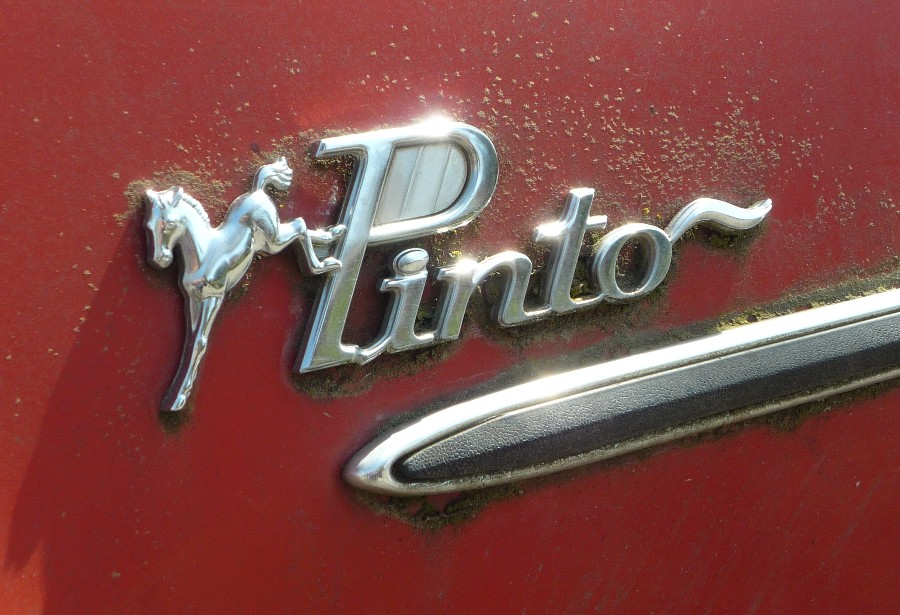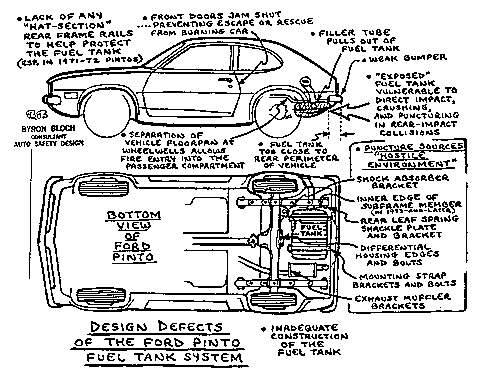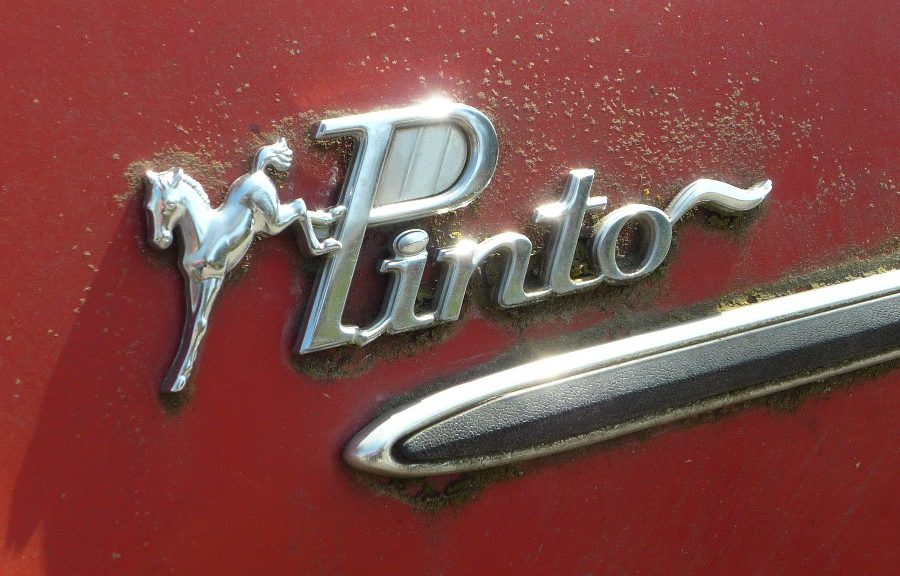 In his autobiography, Iacocca slips in a small discussion of the Fort Pinto. The Ford Pinto was infamous for having been a deadly vehicle in the case of a rear-end accident. If struck from behind, it would burst into flames within seconds. The problem was that the fuel tank was behind the axle + the filler neck on the fuel tank would rip out on impact and then would spill or spray raw gas out. Perfect for starting a fire. In 1971, for $2,000, the Pinto was an affordable compact.
In his autobiography, Iacocca slips in a small discussion of the Fort Pinto. The Ford Pinto was infamous for having been a deadly vehicle in the case of a rear-end accident. If struck from behind, it would burst into flames within seconds. The problem was that the fuel tank was behind the axle + the filler neck on the fuel tank would rip out on impact and then would spill or spray raw gas out. Perfect for starting a fire. In 1971, for $2,000, the Pinto was an affordable compact.
 Joan Claybrook (one of Ralph Nader’s protégés) believed that the Pinto was not an engineering problem but a PR disaster in the making. Internal memos at Ford have been exposed with having weighed the safety risks over the cost saving for customers. Despite the famous Pinto 1973 memorandum, Iacocca denies this stating: “there is no truth to charge that we tried to save a few bucks and knowingly made a dangerous car” (162, Autobiography). Ford voluntarily recalled 1.5 million Pintos in June of 1978, a month before Iacocca was fired.
Joan Claybrook (one of Ralph Nader’s protégés) believed that the Pinto was not an engineering problem but a PR disaster in the making. Internal memos at Ford have been exposed with having weighed the safety risks over the cost saving for customers. Despite the famous Pinto 1973 memorandum, Iacocca denies this stating: “there is no truth to charge that we tried to save a few bucks and knowingly made a dangerous car” (162, Autobiography). Ford voluntarily recalled 1.5 million Pintos in June of 1978, a month before Iacocca was fired.
The Ford Pinto Memorandum
The following figures are drawn from the 1973 memorandum* written for and circulated amongst senior management at the Ford Motor Company concerning cost-benefit analysis of retrofitting or altering production of autos and light trucks susceptible to fires from leaking gas tanks after a hypothetical roll-over.
Fatalities Associated with Roll-Over-Induced Fuel Leakage and Fires
Expected Costs of producing all US cars and light trucks with fuel tank modifications:
- Expected unit sales: 12.5 million vehicles (includes 11 million cars and 1.5 million light utility vehicles built on same chassis)
- Modification costs per unit: $11.00
- Total Cost: $137.5 million
[= 12,500,000 vehicles x $11.00 per unit]
Expected Costs of producing vehicles without fuel tank modifications:
- Expected accident results (assuming 2100 accidents): 180 burn deaths 180 serious burn injuries 2100 burned out vehicles
- Unit costs of accident results (assuming out of court settlements): $200,000 per burn death** $67,000 per serious injury $700 per burned out vehicle
- Total Costs: $49.53 million
[= (180 deaths x $200k) + (180 injuries x $67k) + (2100 vehicles x $700 per vehicle)]
Thus, the costs for fixing the roll-over problem was $137 million, while the computed cost of cases where injuries occur was only $50 million.
*”Fatalities Associated With Crash Induced Fuel Leakage and Fires,” by E.S. Grush and C.S. Saundy, Environmental and Safety Engineering.
**By the way, the $200k and $67k figures for the average value of a lost or injured adult life is drawn from the NHTSA (National Highway Traffic Safety Administration) calculation of the estimated costs to society of automobile accidents. It is not a low-ball figure fabricated by Ford. (For example, the $200k for death was calculated by adding estimated direct costs of $163k — such as loss of future earnings, plus $37k of indirect costs — such as hospital and insurance costs, legal and court costs, victim pain and suffering, funeral costs, and property damage.) This is the calculation typically used by the U.S. Federal government for performing cost-benefit analyses of highway construction projects (e.g. determining how safely we should build our roads and highways). Even today, such figures are commonly used by many state and local, as well as federal, government agencies to weigh costs of various tax-supported programs.
Thesis: Management Decisions are Harder without Hindsight
In this article I will play devil’s advocate in defending Lee Iaccocca against what is rather compelling criticism. I maintain that Iaccocca is not in fact an evil CEO nor should he have been fired.[1] My argument is that a) safety norms in the 1970s are dramatically different to today, b) the Ford Pinto is a particularly memorable case but the auto industry produces a deadly product and c) there are limits to how safe such a dangerous product can be. I will conclude by pointing out that when selling potentially lethal products there are trade offs between affordability and safety that consumers took and efforts such as Ralph Nader’s team to increase awareness of those tradeoffs is laudable for consumers to understand and consider. But ethically, this is complicated, folks!
The Active Agent: Lee Iaccoca, Marketing Brilliance
The active agents in the Ford Pinto case are the executives in the Ford Project Planning committee. I will focus on Iaccocca because…honestly, I’ve read his autobiography and he is most responsible. His core ethical choice is whether to rush to market a subcompact to compete against low-cost Japanese competitors, mind you this would be without the recommended safety changes to the tank. The cost of delays would be loss of profit maximization against competition using his glitzy “2000lbs for $2000” Pinto[2].
The Other Active Agents: Engineers and Employees, Whistle-blwong as a Career Limiting Move
The other active agents are the engineers and employees who effectively risk their jobs should they whistle blow Iaccocca’s wreckless push to get the Pinto on the market ASAP. If you have four kids, and you want to stay in the Detroit area, then you would be ill advised to cause trouble as none of the other automakers would likely hire you after your dismissal. On the other hand, with hindsight, it is easy to say this car posed an unnecessary risk to consumers relative to other cars but perhaps it wasn’t that obvious at the time. I can imagine these engineers thinking that the conditions for the Pinto to explode are very specific, the magnitude of the risk is predictive rather than certain and if this car proves to be dangerous on the road, they can issue a recall and install rubber blades at a later date. How forcefully can an engineer make the argument to hell-bent executives like Iacccoca? Not very.
The Passive Agents: Oblivious Customers
The passive agents in this case are people like my in-laws whose first car was in fact the Ford Pinto 1971. They happen to love this car because it was safer than the motorcycle my father-in-law had to sell to cover the cost of the purchase. Relative to a motorcycle, the Pinto is possibly on par or slightly safer still. Also, the cheapness allowed my in-laws new freedom that would be beyond their reach at the time. It’s hard to measure the benefits of low-cost transportation on the economy and society which should be considered in weighing this case. For maybe $500, they could have bought a more expensive but less explosive car. As passive agents however, the marketing campaign for the Pinto did not highlight the design flaw of course. That is an ethical lapse from a Rawlsian standpoint, as I would want to know if what I was buying had a specific flaw. But Rawl is a philosopher and a car salesperson is a…car salesperson. Although that assertion of an ethical lapse (by not sharing the facts with customer) is complicated by the fact that Iaccocca was true risk taker who might say he would accept the risks of selling a cheap car without expecting the details of why it is so cheap.
Unsafe By Today’s Standard: Progress Is Not A Straight Line
An important point I want to make is that life was dramatically more unsafe in the 1970s than today, so we shouldn’t judge society then by today’s standard no matter how tempting. People used to interact with all kinds of dangerous products more directly. Government regulation was not imposed as forcefully. There were lower standards for safety generally as evidenced by the need for Ralph Nader’s Unsafe at Any Speed published in 1965 well before the Pinto. It wasn’t just Ford that was making unsafe vehicles in the era. The Chevrolet Corvair was considered the ‘one-car accident’ with a high rollover rate, with tire pressures requirements that a customer would be unlikely to notice… There are all kinds of design features that add to the risk of accidents, like shiny car dashboards. And some of the choices are shaped by ideological values, sleek design, cost and even comfort. Nader made his appeals and over a career change happened, but business is business. A lack of seat belts, sloping grills that push a pedestrian down and under in a collision,
Laissez Faire Capitalism versus Regulatory Costs
To understand Iaccocca, you have to look at who he is aligned with ideologically. He is a disciple of the Milton Friedman Chicago School of Economics. That school entails restricted government intervention, where consumer demand guides product development. For example, if the cost of a seatbelt is $50 per car and you are competing against automakers who sell 2 million cars a year while you sell 500,000 cars, you have a major economies of scale disadvantage and therefore aren’t likely to want government to force you to make your car safer[3]. In fact, R&D was not shared between competing firms so Chrysler had to spend much more just to get their seatbelt technology up to snuff. You can imagine this same logic being applied to the Ford Pinto minus the competitors. $11 is a lot of additional cost, not including installation, which may or may not be baked into the process of building these cars. It is the perverse Utilitarianism of weighing the costs and benefits of Iaccocca’s choice that irks everyone so much from a public relations perspective. Putting a litigation price tag on the anticipated victims of rollovers exposes a cruel and calculated inner workings at Ford. However, I argue that this is the core problem with balancing affordability with safety. If the market cared more about safety they would have demanded it, say the Friedman-ites…well, consumers only have so much buying power, hence the need in some scenarios for regulations that impose safety standards…and if it hurts the smaller players then surely
Could Have Held Off If He Had the Facts
Iaccocca deserves more scrutiny, of course, he didn’t listen to Ralph Nader or read his book, I suspect. Did he have all the facts? Maybe he didn’t know about the gas tank? $11 dollars more to fix a gas tank problem? Did Iaccoca know that expensive stylist features could be swapped out in met the breakeven of $11 as Ralph Nader might have argued. Did Iaccoca ask at a timely point, how serious is the gas tank problem? Okay, it’s serious, why not download that cost to the customer and charge $22 more? Because 2,000 lbs for $2022 doesn’t have the same ring to it! He had the authority to hold off the launch of the Pinto but he chose to overlook the risks to customers. There was a critical juncture at the design stage that Iaccoca and others would have missed where putting gas tank at the back of the chassis could have been vetoed. Iaccoca was too late.
Utilitarianism
From a Utilitarian perspective, the tragedy for victims is immense as the Pinto could be lethal. The total number of Ford Pinto victims ranges from 23 to approximately 500. As the NHTSA places a human being’s value at $200,725, we are talking about 100 million dollars of lost economic productivity. AS mentioned above, one of the reasons the Ford Pinto is so famous is the Ford’s Cost Benefit Analysis. Did Iaccocca maximize the benefits for the most number of people? In a way, Ford tried to maximize the benefits to shareholders but likely caused brand equity harm. Depending on your perspective I can argue that 500 deaths for 7.5 million cars is actually quite low. Of course, the nature of these burning deaths is hard to ignore.
Contractarian: Lying by Omission
From a Contractarian perspective, the commercial consequences of the 1978 recall would likely contravene Ford’s explicit responsibility to their shareholders by harming Ford’s market equity, although that is hard to measure. The Pinto also contravenes the implicit contract with consumers in not making it clear that that the Pinto was a risky car to drive. From the End-Statism perspective, the recall was indeed not the right outcome for Ford either.
Conclusion: A Mixed Bag
Iaccocca made many decisions as CEO of Ford and later Chrysler that would prove controversial. He also helped create the Mustang and the MiniVan. Success has many fathers but failure is an orphan. “Lee’s Car” as it is referenced is not Iaccocca’s anymore. In the autobiography. Iaccocca is far from accepting of blame. He spends all of 2 pages addressing the Pinto controversy and does effectively admit that mistakes were made[4]. “Mistakes Were Made” is a convenient euphemism because it does not include inculpation or exculpation relating to accountability. In that sense Iaccocca does not pass the Hyper Norms test for any of the key concepts from honesty to transparency (as the cost benefit analysis was a leak). Ironically, considering the tragedy of the Pinto, Iaccocca is still lauded as one of the greatest CEOs in American history so the consequences are mixed in with major industry successes for Iaccoca.
[1] He was fired as CEO of Ford for other reasons coincidently as the recall for the Ford Pinto began in 1978, according to Iaccocca: An Autobiography.
[2] From the Moral Ethics and Business article.
[3] Iaccocca’s argument is in Iaccocca: An Autobiography, page 256.
[4] Iaccocca: An Autobigraphy page 205.


One thought on “Lee Iacocca: Don’t Elaborate Much On Your Deadly Mistakes”